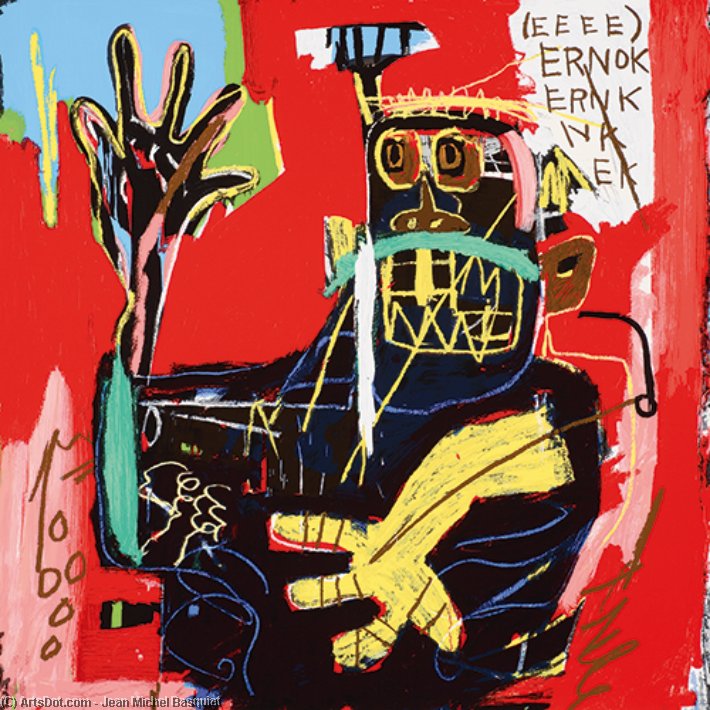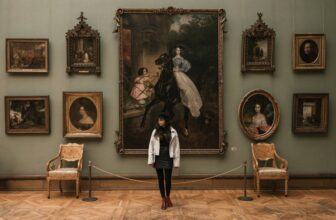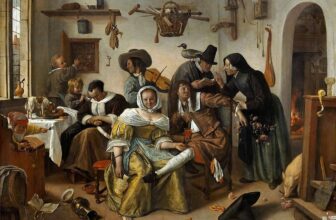
Meaning of Untitled (Ernok) Painting by Jean‑Michel Basquiat
Let’s dive into the layered canvas of Untitled (Ernok) by Jean‑Michel Basquiat, exploring its origins, symbols, visual drama, and ongoing legacy.
Although the edition we know as Untitled (Ernok) was produced in 2001 as part of Portfolio I, its artistic roots trace back to Basquiat’s 1982–83 original painting titled Ernok. The 2001 silkscreen print, a 40‑inch square executed on high‑quality wove paper, was produced by Brand X Editions in New York and published by DeSanctis Carr Fine Art in LA, with only 85 numbered prints and 15 artist proofs. Each bears the estate stamp and signature of Basquiat’s father, Gerard, making it both authentic and historically grounded .
Who & How
Jean‑Michel Basquiat (1960–1988), originally a graffiti artist (SAMO©) in early 1980s New York, rose through art circles into global fame as a key Neo‑Expressionist voice .
Ernok was conceived circa 1982–83 before his untimely death in 1988. The 2001 print reissue was overseen by the Basquiat Estate and produced with meticulous care to reflect his hallmark layered aesthetic .
Visual Narrative & Scene
At first glance, Ernok immerses you in a cacophony of color and form:
A dominant black figure dominates the center, suggestive of a man or male form.
His right hand appears translucent, mapped with X‑ray veins, as if exposing internal life.
A vivid crimson field dominates the left, evoking blood, passion, or emotional turmoil.
Amid scattered scribbles, signs, and shapes, there’s an almost x-ray realism clashing with abstract calligraphy and graffiti, Basquiat’s visual tension at full throttle.
Symbolism & Meaning
1. Anatomy as Exposure & Vulnerability
Basquiat’s fascination with anatomy began young when hospitalized, receiving Gray’s Anatomy, which cemented his lifelong interest in revealing flesh and bone . Ernok continues this exploration, transparency isn’t physical but psychological, a revealing of pain, identity, and humanity under the microscope.
2. Internal vs. External
The translucent hand suggests the dual gaze society places on black bodies: what you present vs. what is interpreted. It’s a confrontation of self-awareness and societal gaze .
3. Neo‑Expressionist Gesture & Urban Roots
Bold brushwork, scattered text, and graffiti aesthetics tie Ernok into Basquiat’s signature style, part urban scribble, part raw emotion. His Afro‑Caribbean heritage, graffiti beginnings, and Neo‑Expressionism all collide here .
4. The Wordplay & Fragmentation
The title “Ernok” itself evokes mystery. Some see it as a reverse acrostic, a fragment of speech disrupted like identity under pressure . The fractured letters echo fractured identity and culture.
5. Crown Motif & Social Hierarchies
Basquiat frequently crowned figures to signify greatness and reverence, often elevating marginalized individuals and black cultural icons . While not obvious here, echoes of that symbolism may still hover: the figure could be a crowned survivor, powerful yet wounded.
What’s Happening on the Canvas?
Identity in the Margins: A dark figure at center, his fractured hand airs vulnerability, yet he stands confrontational, defying erasure.
Blood & Energy: Red around him pulses with vitality, or anger, or pain, with layered blue/green strokes imbuing emotional complexity.
Fragmentation of Self: Scribbles and fragmented words act like digital artifacts, echoes of a mind or culture trying to piece itself together.
Dialogue with Death: Basquiat’s skulls and corpses often recall racial violence. Here, the internal view hints at mortality yet insistence on surviving, Breathing, seeing, resisting .
Urban Graphic Voice: Textured, raw strokes, graffiti-like text, scrawls, all assert a proud urban heritage, rooted in streets and struggle.
Artistic Style & Classification
Neo‑Expressionism: Bold brushwork, emotional intensity, raw figurative forms, Basquiat’s hallmark.
Street Art / Graffiti Influence: Scrawled text, urban lettering, jittery gestures, echoes of his SAMO© roots .
Mixed‑Media Screenprint: The 2001 edition is a 21‑color screenprint, layering the form and color complexity of the original into a high-end print format .
A fusion of text and image: Basquiat’s unique funneling of words into art, text becomes visual texture and meaning .
Provenance & Where It Lives
Printed: 2001, under Basquiat estate oversight .
Editions: Held across elite collections, galleries, auction houses, recently sold at Sotheby’s (2021) and Van Ham (2023).
Today, most copies remain in private collections. Galleries like Guy Hepner, Upsilon Gallery, Georgetown Frame Shop, and online platforms occasionally exhibit or broker the work .
Public display is rare, Basquiat’s works are mostly in museums (The Broad, Brooklyn Museum, etc.), but Ernok prints occasionally feature in traveling shows from Portfolio I.
Cultural & Lasting Significance
Mortality & Race: Reveals how black bodies are socially exposed, seen, accused, dehumanized, romanticized.
Legacy of Disruption: Basquiat’s fusion of graffiti, Neo-Expressionism, and textual collage shattered art world expectations.
Emotional Resonance: “Reader” or viewer is invited to confront the pain and beauty within.
Market & Collectibility: High auction prices (£70k–100k; $60k–80k) reflect growing recognition for Basquiat’s screenprints, especially from Portfolio I .
Narrative Power: As part of Portfolio I, Ernok is linked to a quartet (with Head, Per Capita, Rinso) that uses repetition to reinforce Basquiat’s commentary on society, identity, commodification.
Untitled (Ernok) encapsulates Basquiat’s genius: an emblem of social and personal interrogation, crafted through layers of color, text, and raw feeling. It symbolizes:
Internal struggle made visible, bones, veins, emotions laid bare.
Racial and existential confrontation, a mirror to how Black identity is dissected by society.
Artistic rebellion, a canvas where Neo‑Expressionism meets street-level urgency, written in paint and words.
Lasting cultural weight, resonating across collectors, critics, institutions, and activists.
When you see Ernok, you’re not just viewing a figure, you’re engaging in a conversation through time, layered in paint, pain, and purpose. Basquiat used this powerful print to say, “Look. Know. Listen.”
Where to Enjoy / Acquire It
Institutional Exhibitions: Check larger Basquiat museum retrospectives (Brooklyn Museum, Brant Foundation, etc.).
Prominent Galleries: Works appear occasionally at Upsilon Gallery (NY/UK), Guy Hepner, Maddox Gallery.
Auction Houses: Sotheby’s, Christie’s, Philips, Van Ham often list Ernok under “Important Prints & Multiples.”
Private Sales: Brokerages like Georgetown Frame Shop or Grun Art offer prints, though typically confidentially.
Reflective Questions
What does Basquiat expose in Ernok that is still unspoken today?
How do the fragmented words and images speak differently than a pure portrait would?
Can you see yourself in the transparent hand, revealing your own internal scars and stories?
Untitled (Ernok) challenges and engages. It’s more than art, it’s an experience and a question.
Sources & Further Reading
For deeper exploration:
Sotheby’s auction catalogue
Guy Hepner’s gallery analysis
Maddox Gallery’s thematic essay on Portfolio I
Wikipedia and art-historical context of Basquiat’s practice




